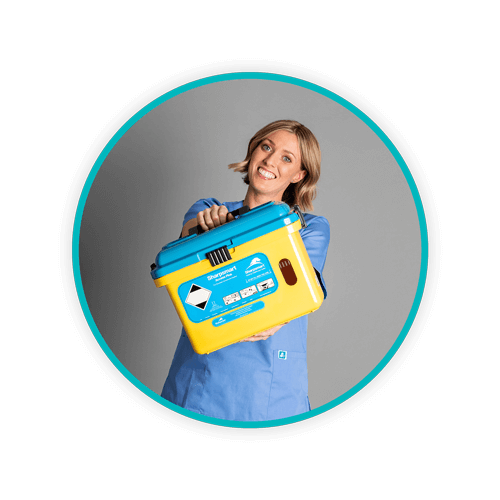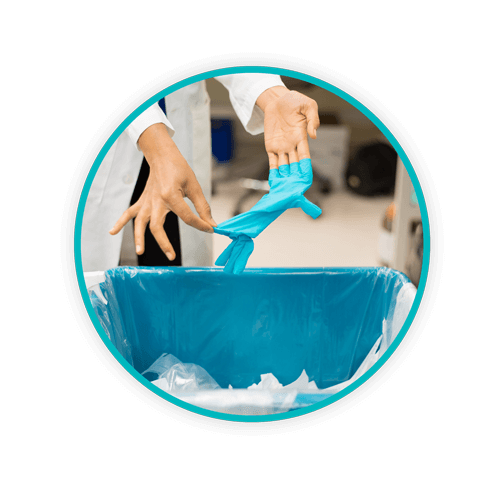6 New Year’s Resolutions to Improve Waste Management and Compliance

With the start of the new year it’s the perfect time to assess your hospital or healthcare facility’s current waste management processes. With ever-changing rules and guidelines for healthcare and hazardous waste management, it’s important to ensure that your facility is compliant. This reduces the risk of unscheduled inspections, audits, and alarming fines and penalties.
guidelines for healthcare and hazardous waste management, it’s important to ensure that your facility is compliant. This reduces the risk of unscheduled inspections, audits, and alarming fines and penalties.
Check out these New Year’s resolutions for cost-effective solutions that can improve waste management practices your facility currently has in place.
New Year's Resolutions:
2 / Waste Segregation and Minimisation
3 / Adopt Sustainable Waste Containers
6 / Look for Recycling Opportunities
Resolution #1: Education and Training 
Ensure that every staff member can identify the difference between clinical waste and non-clinical waste. Clinical waste is the term used to describe waste produced from healthcare and similar activities that may pose a risk of infection to any person coming in contact with it. Non-clinical wastes are those that are non-infectious and do not contain any pharmaceutical or chemical substances. Non-clinical wastes are also non-hazardous. Every employee should be aware of and understand specific state laws and definitions for different waste streams.
Resolution #2: Waste Segregation and Minimisation
Take steps to minimise the volume of waste produced by your facility. This means proper identification of waste streams by following approved (and compliant) methods of handling and disposing of each. Be aware that any time waste streams are mixed, that waste must be treated at its highest level of danger. For example, if even one piece of clinical waste ends up in a non-clinical waste bin, that entire contents of that bin must be disposed of as clinical waste. As a general rule, the greater the risk associated with the waste, the higher the disposal costs.
Resolution #3: Adopt Sustainable Waste Containers 
If your facility is not doing it already, opt for reusable waste containers to handle a variety of waste streams in your environment. Reusable containers have been clinically proven to reduce a healthcare settings global warming potential. Colour-coded containers in medical scenarios are an excellent way to not only save money, but to maintain compliance. Doing so is also beneficial to the environment and reduces potential for contamination with other waste streams or to those handling such waste.
Resolution #4: Prepare for the Worst
Every healthcare-based facility regardless of size should have an emergency readiness plan in place. It’s not enough to post the emergency plan, but to train all employees to put those plans into action. This applies to mock fire drills and evacuation drills. Maintain a current list of individuals from each department who are responsible for activating emergency operations, and their specific roles and responsibilities.
Resolution #5: Self Audit
Perform routine audits to ensure that every department within a facility or hospital is following best practices regarding waste minimisation and proper segregation. Waste audits are essential in discerning hospital or healthcare facility waste streams, which offers potential cost savings. A waste audit can ensure that your facility is in compliance with not only regulations but waste minimisation goals that are set by government agencies.
Resolution #6: Look for Recycling Opportunities 
Following along the lines of Resolution #5, a waste audit helps in the identification of waste categories and subcategories in any healthcare environment. Audits also aid in the identification of items that can be reused or recycled, such as computers or electronics. Recycling opportunities are found by identifying subcategories such as plastics, glass, paper, cardboard, and so forth. Reduce waste management costs by reducing or recycling wastes that don’t require special handling.
Start the New Year off right
These are just a few tips and strategies to improve waste management in hospital and other healthcare environments. Do your part to ensure that best processes are used in your facility to minimise waste generation and to reduce the volume of waste that ends up being treated through carbon intensive processes.
Sharpsmart wants to encourage all hospitals and healthcare facilities, regardless of size, scope, or location, to improve waste management strategies that not only ensure compliance, but protect human health and the environment. For more information on Sharpsmart’s sustainable and cost-effective products, services, and resources, contact us today.
